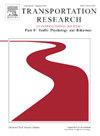The effect of cognitive load on driver situational awareness under partially automated driving conditions
IF 3.5
2区 工程技术
Q1 PSYCHOLOGY, APPLIED
Transportation Research Part F-Traffic Psychology and Behaviour
Pub Date : 2025-06-25
DOI:10.1016/j.trf.2025.06.020
引用次数: 0
Abstract
With the development of automated driving technology, level 2 (L2) automated systems have transformed the role of drivers, leading to changes in cognitive loads (including both physiological and psychological factors). Under partially automated conditions, drivers are prone to fatigue and disengagement, which reduces Situation Awareness (SA). The distribution of attention and the level of SA are critical to driving performance and safety. To investigate how SA varies under different cognitive loads during extended periods of automated driving, a high-fidelity driving simulator and eye-tracking technology were employed to collect data. The impacts of the automation level (manual vs. L2), cognitive channel (visual vs. auditory), and cognitive load (no load, 0-back, or 1-back) on drivers’ SA during extended driving were examined. In the simulation, a suburban road environment, including potential hazard scenarios and SA measurement tasks, was modeled. The results indicate that cognitive load influences drivers’ subjective cognitive loads and situational awareness scores. Overall, the cognitive load during L2 automated driving is lower than that during manual driving. As the driving time increases, drivers’ situational awareness tends to decrease. After 40 min of driving, a decrease in the subjective situational awareness score occurs. The distribution of drivers’ gaze points is influenced by automation, cognitive load, and their interaction. Gaze transition probability influenced by driving duration and cognitive load level, with the gaze concentration effect occurring after prolonged driving. Additionally, as the driving time increases, eye movement indicators such as the number of fixations on potential hazards and fixation entropy decrease, whereas the pupil coefficient of variation increases. This study reveals the relationship between cognitive load and SA, showing that visual metrics can effectively reflect drivers’ SA. These results provide valuable insights for designing driving cues that reflect drivers’ current state.
部分自动驾驶条件下认知负荷对驾驶员态势感知的影响
随着自动驾驶技术的发展,二级(L2)自动驾驶系统改变了驾驶员的角色,导致认知负荷的变化(包括生理和心理因素)。在部分自动化的情况下,驾驶员容易疲劳和脱离驾驶,从而降低了态势感知(SA)。注意力的分布和SA的水平对驾驶性能和安全至关重要。为了研究长时间自动驾驶中不同认知负荷下SA的变化,采用高保真驾驶模拟器和眼动追踪技术采集数据。考察了自动驾驶水平(手动vs L2)、认知通道(视觉vs听觉)和认知负荷(空载、0回、1回)对驾驶员长时间驾驶过程中SA的影响。在模拟中,模拟了郊区道路环境,包括潜在危险场景和SA测量任务。结果表明,认知负荷影响驾驶员的主观认知负荷和情景意识得分。总体而言,L2自动驾驶时的认知负荷低于手动驾驶时。随着驾驶时间的增加,驾驶员的态势感知有降低的趋势。驾驶40分钟后,主观情境意识得分下降。驾驶员注视点的分布受自动化程度、认知负荷及其交互作用的影响。注视转移概率受驾驶时间和认知负荷水平的影响,注视集中效应发生在长时间驾驶后。此外,随着驾驶时间的增加,对潜在危险的注视次数和注视熵等眼动指标减少,而瞳孔变异系数增加。本研究揭示了认知负荷与SA之间的关系,表明视觉指标可以有效地反映驾驶员的SA。这些结果为设计反映驾驶员当前状态的驾驶提示提供了有价值的见解。
本文章由计算机程序翻译,如有差异,请以英文原文为准。
求助全文
约1分钟内获得全文
求助全文
来源期刊
CiteScore
7.60
自引率
14.60%
发文量
239
审稿时长
71 days
期刊介绍:
Transportation Research Part F: Traffic Psychology and Behaviour focuses on the behavioural and psychological aspects of traffic and transport. The aim of the journal is to enhance theory development, improve the quality of empirical studies and to stimulate the application of research findings in practice. TRF provides a focus and a means of communication for the considerable amount of research activities that are now being carried out in this field. The journal provides a forum for transportation researchers, psychologists, ergonomists, engineers and policy-makers with an interest in traffic and transport psychology.

 求助内容:
求助内容: 应助结果提醒方式:
应助结果提醒方式:


